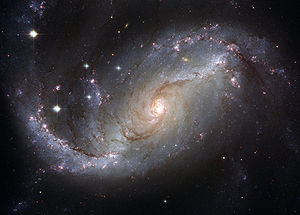- NGC 1672
-
NGC 1672 
A Hubble Space Telescope (HST) image of NGC 1672.Observation data (J2000 epoch) Constellation Dorado Right ascension 04h 45m 42s[1] Declination -59° 14′ 56″[1] Redshift 1331 ± 3 km/s[1] Type (R')SB(r)bc[1] Apparent dimensions (V) 6′.6 × 5′.5[1] Apparent magnitude (V) 10.3[1] Other designations PGC 15941[1] See also: Galaxy, List of galaxies NGC 1672 is a barred spiral galaxy located in the constellation Dorado. It was originally thought to be a member of the Dorado Group,[2] however, this membership was later rejected.[3] NGC 1672 has a large bar which is estimated to measure around 20 kpc.[4] It has very strong radio emissions emanating from its nucleus, bar, and the inner portion of the spiral arm region.[4] The nucleus is Seyfert type 2 and is engulfed by a starburst region.[4] The strongest polarized emissions come from the northeastern region which is upstream from its dust lanes.[4] Magnetic field lines are at large angles with respect to the bar and turn smoothly to the center.[4]
Contents
General structure
The center of the galaxy contains a high surface brightness bar, and four filament-like spiral arms extend outward from the ends of this bar. The spiral arms are asymmetric; one of the arms in the northeast part of the disk is significantly brighter than its counterpart on the other side. The spiral arms also contain numerous star formation regions, some of which may be as large as 4′′.[5]
Nucleus
The classification of the nucleus of NGC 1672 is uncertain. Most galaxies may be classified by their spectra as having one of three different types of nuclei:[6]
- A nuclear HII region, a region which has a spectrum similar to that of star formation regions in the Milky Way and which therefore is associated with nuclear star formation activity.
- A Seyfert nucleus, a type of active galactic nucleus (AGN) that may contain a supermassive black hole.
- A low ionization nuclear emission-line region, a type of nuclear region with spectral line emission from weakly ionized gas that could contain either a star formation region or a supermassive black hole.
NGC 1672, however, is one of several nearby galaxies that does not fit into this classification scheme, as its spectrum appears intermediary between these three classes of objects.[6] It may in fact contain both nuclear star formation regions and an AGN. In some wave bands (such as in ultraviolet light), the star formation regions are the primary source of emission.[7]
See also
- NGC 1300 - a similar spiral galaxy
External links
References
- ^ a b c d e f g "NASA/IPAC Extragalactic Database". Results for NGC 1672. http://nedwww.ipac.caltech.edu/. Retrieved 2007-04-04.
- ^ Huchra, J. P.; Geller, M. J. (June 15, 1982). "Groups of galaxies. I - Nearby groups". Astrophysical Journal 257 (Part 1): 423–437. Bibcode 1982ApJ...257..423H. doi:10.1086/160000.
- ^ Maia, M. A. G.; da Costa, L. N.; Latham, David W. (April 1989). "A catalog of southern groups of galaxies". Astrophysical Journal Supplement Series 69: 809–829. Bibcode 1989ApJS...69..809M. doi:10.1086/191328. ISSN 0067-0049.
- ^ a b c d e Beck, R.; Shoutenkov, V.; Ehle, M.; Harnett, J. I.; Haynes, R. F.; Shukurov, A.; Sokoloff, D. D.; Thierbach, M. (August 2002). "Magnetic fields in barred galaxies. I. The atlas". Astronomy and Astrophysics 391 (1): 83–102. arXiv:astro-ph/0207201. Bibcode 2002A&A...391...83B. doi:10.1051/0004-6361:20020642.
- ^ A. Sandage, J. Bedke (1994). Carnegie Atlas of Galaxies. Washington, D.C.: Carnegie Institution of Washington. ISBN 0-87279-667-1.
- ^ a b P. Veron, A. C. Goncalves, M. P. Veron-Cetty; Goncalves; Veron-Cetty (1997). "AGNs with composite spectra". Astronomy and Astrophysics 319: 52–66. Bibcode 1997A&A...319...52V.
- ^ A. L. Kinney, R. C. Bohlin, D. Calzetti, N. Panagia, R. F. G. Wyse (1993). "An atlas of ultraviolet spectra of star-forming galaxies". Astrophysical Journal Supplement Series 86: 5–93. Bibcode 1993ApJS...86....5K. doi:10.1086/191771.
Categories:- Barred spiral galaxies
- Seyfert galaxies
- LINER galaxies
- Dorado constellation
- NGC objects
- PGC objects
Wikimedia Foundation. 2010.
